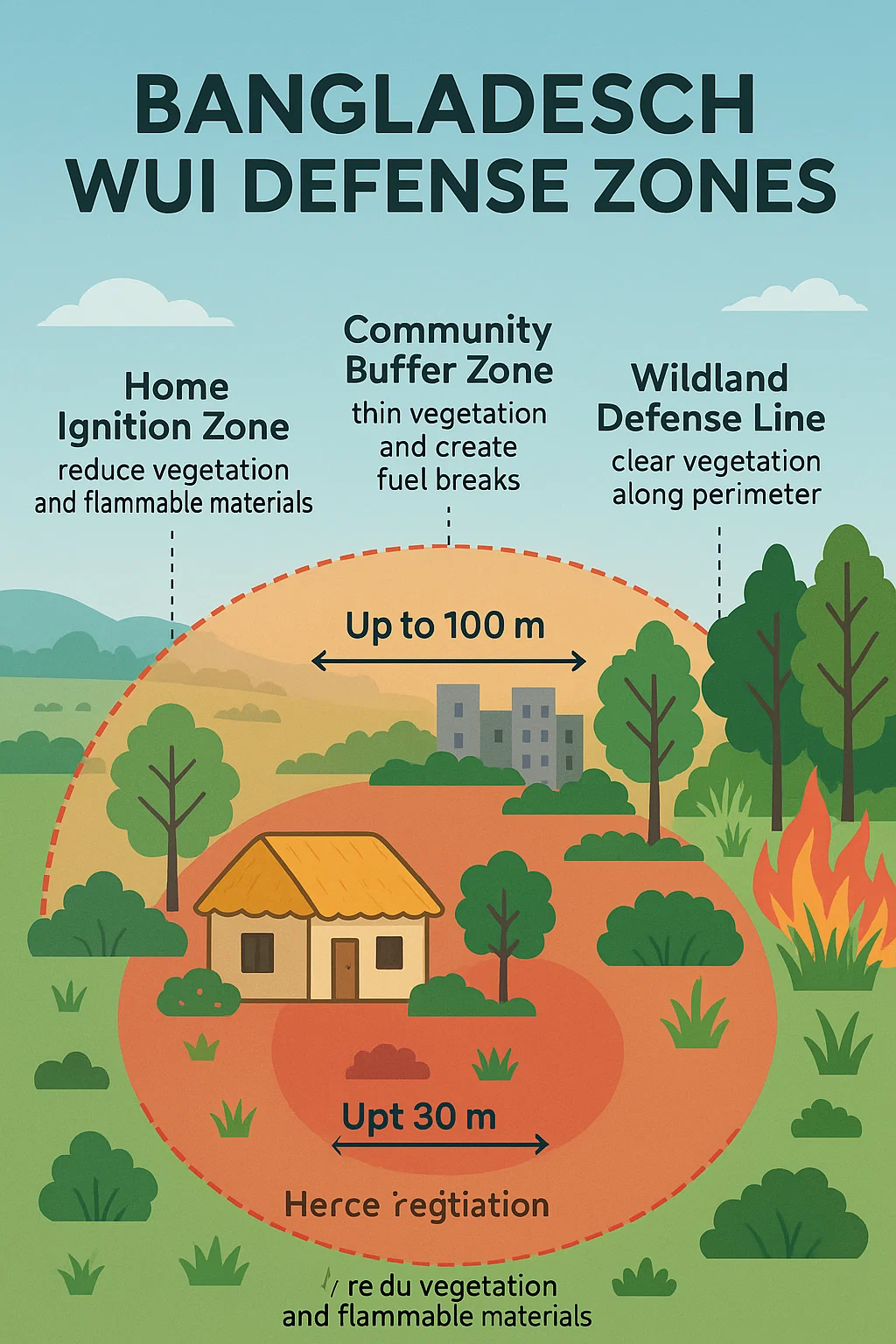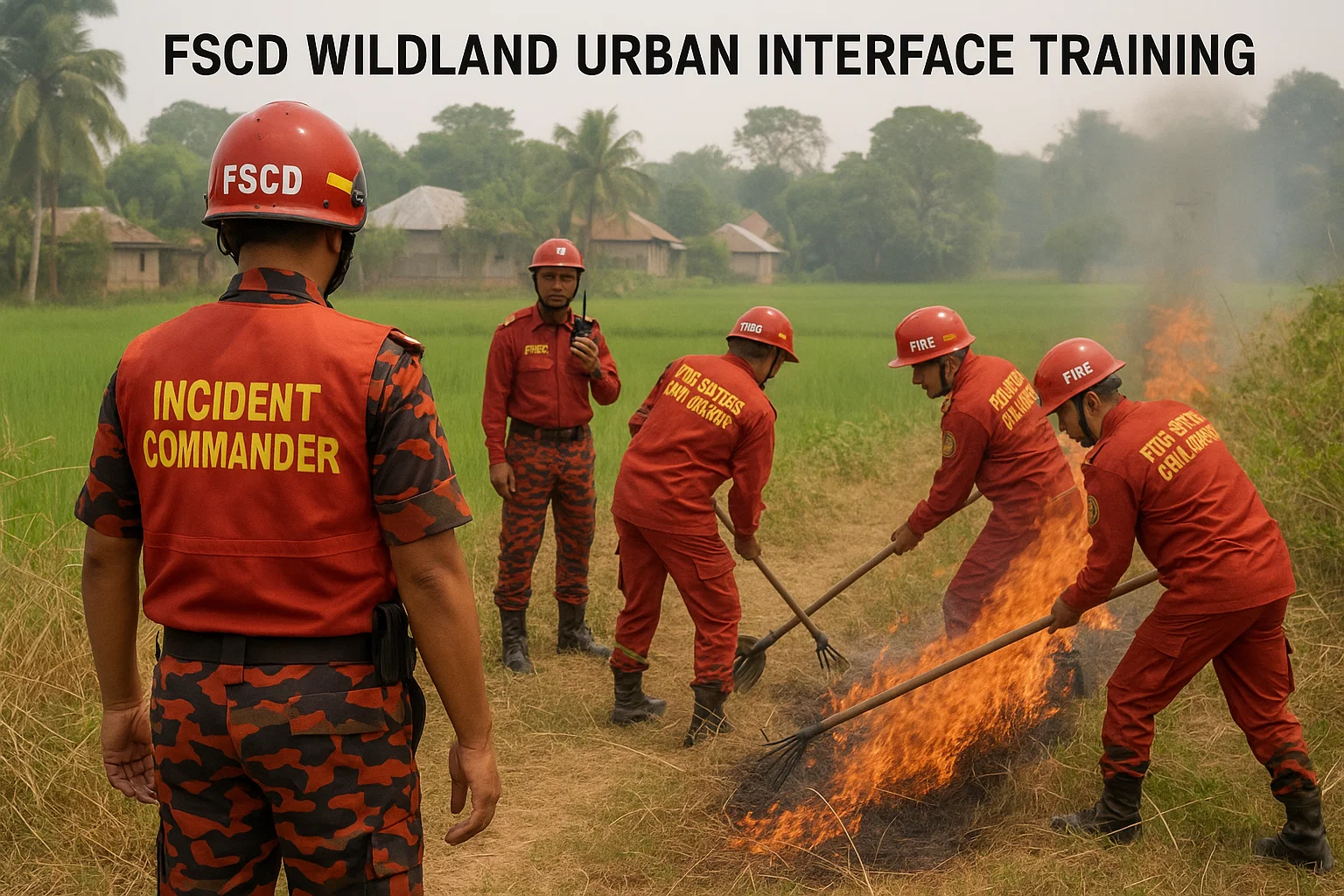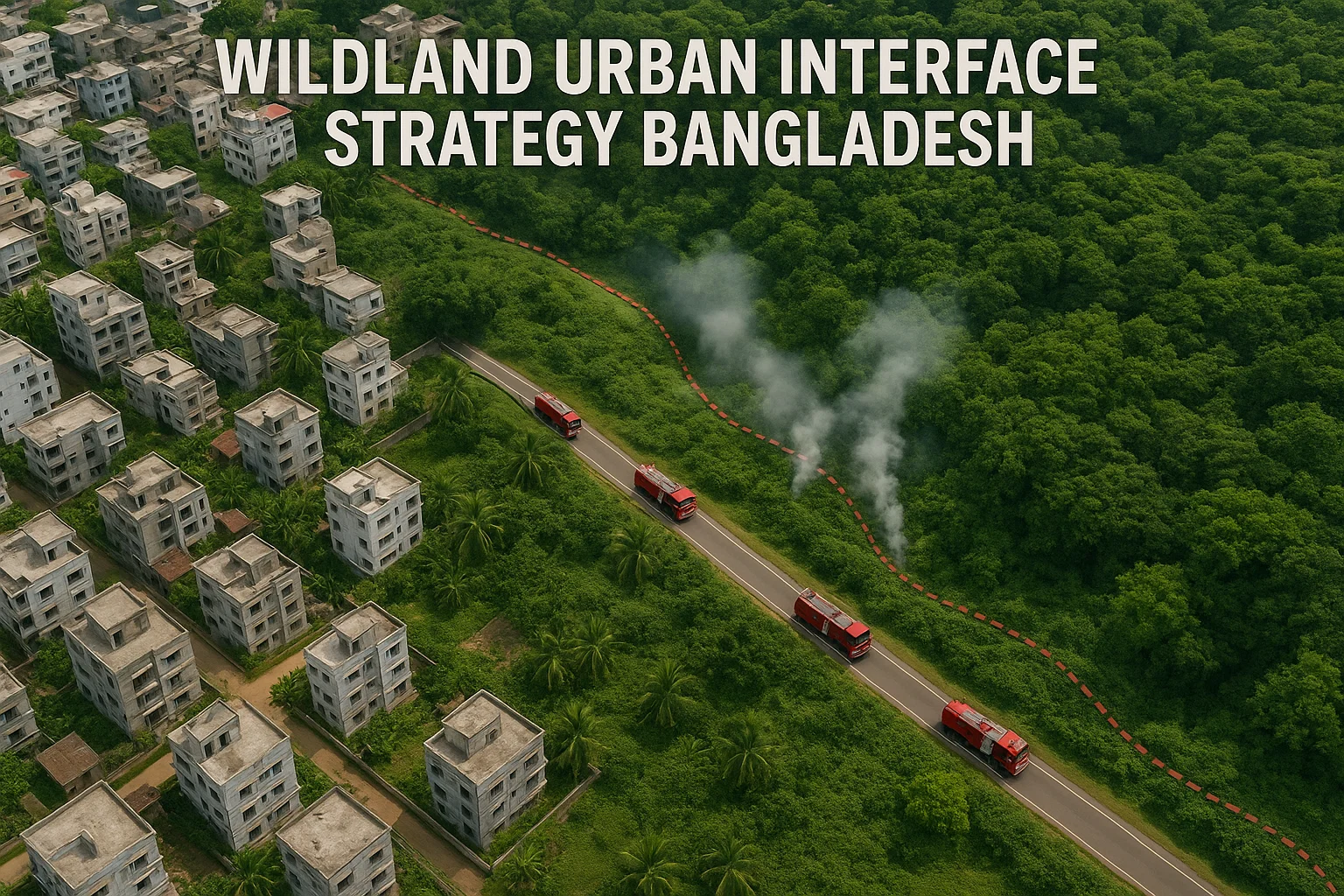 Understanding the Bangladesh Context
Understanding the Bangladesh Context
Bangladesh’s expanding towns, mixed with scattered vegetation and informal housing, are developing a fragile frontier where cities meet combustible lands. The wildland–urban interface (WUI) is no longer limited to hilly or forest districts like Sylhet or Chittagong Hill Tracts; peri-urban Dhaka, Gazipur, and Cox’s Bazar also exhibit WUI hazards.
Rapid population growth, unregulated construction, and seasonal droughts create fuel continuity between natural vegetation and man-made structures. In these transition zones, even a minor grass burn or waste fire can escalate into structure ignition within minutes.
The Fire Service and Civil Defence (FSCD) has begun integrating international guidelines chiefly NFPA 1141 (Fire Protection Infrastructure for Land Development) and NFPA 1144 (Reducing Structure Ignition Hazards from Wildland Fire) into regional planning. Combined with local climatic understanding, these standards form the backbone of a sustainable national WUI strategy.
Strategic Framework for WUI Management
A successful WUI program merges policy, engineering, and operational response. The framework for Bangladesh comprises five tiers:
| Tier | Focus | Lead Agency | Key Output |
|---|---|---|---|
| 1 | Policy & Codes | MoHA / FSCD HQ | National WUI Strategy Document |
| 2 | Risk Mapping & Zoning | FSCD + LGED + DoE | GIS-based Fire Hazard Atlas |
| 3 | Community Risk Reduction | FSCD Regional Stations | CRR Plans & Public Education |
| 4 | Response Operations | FSCD District Commands | ICS-aligned Incident Playbooks |
| 5 | Post-Fire Recovery | District Administration + DoE | Debrief Reports & Rehabilitation Plans |
Each tier builds resilience policy sets direction, zoning limits exposure, CRR changes behavior, ICS ensures control, and recovery locks in learning.
Mapping and Zoning the WUI Landscape
Data Integration
Risk mapping begins with satellite imagery (Sentinel-2, Landsat-9) and FSCD incident logs. Factors include vegetation type, slope, wind corridors, proximity of dwellings, and road access.
Zoning Classifications
Bangladesh should adopt three WUI classes:
- Interface Zone: Dense settlements abutting forest edges.
- Intermix Zone: Dispersed homes within continuous vegetation.
- Occluded Zone: Pockets of vegetation within built-up city blocks.
Each class dictates minimum defensible-space requirements and resource allocation.
GIS Applications
The Fire Risk GIS Cell (under FSCD HQ Planning Division) should maintain a live WUI dashboard showing seasonal fire indices (using MODIS Fire Information for Resource Management System data). This aids in early public warnings and crew deployment.
Pre-Incident Preparation
Fuel Management
Bangladesh’s WUI fuels include dry bamboo, thatch, and invasive shrubs like Lantana camara. A 30 m defensible space is recommended around each structure:
- 0–10 m: Non-combustible zone paved paths, trimmed grass, no fuel storage.
- 10–20 m: Reduced-fuel zone scattered trees, pruned to 2 m clearance.
- 20–30 m: Managed vegetation zone controlled grazing or green breaks.
Municipal by-laws should require annual clearance before April, enforced by local Ward Safety Committees.
Water Supply and Access
NFPA 1141 calls for a minimum fire-flow of 1,000 gpm (≈ 3,785 L/min) within 305 m of structures. In peri-urban Bangladesh, portable collapsible tanks (10,000 L) and natural ponds can substitute hydrants if equipped with hard-suction fittings. FSCD should map all static water sources.
Training and Simulation
Quarterly drills under ICS structure with Divisional Command as Incident Commander (IC), local station officer as Operations Chief, and Ward Chair as Public Information Officer (PIO) ensure unified response.
Pro Tip 💡 Use small-scale fuel plots for live-fire practice; they replicate flame behavior safely and teach nozzle discipline.
Incident Command and Operational Control
ICS Structure for WUI Incidents
| ICS Role | Typical Officer Rank | Primary Duties |
|---|---|---|
| Incident Commander (IC) | Divisional Officer | Strategy, liaison with District Admin |
| Operations Section Chief | Station Officer | Fireline creation, suppression tactics |
| Planning Section Chief | Sub-Officer | Weather monitoring, map updates |
| Logistics Chief | Equipment Officer | Water supply, vehicle support |
| Safety Officer | Senior Crew Leader | PPE check, crew rotation |
| Public Information Officer | Ward Rep / FSCD PRO | Community warning & media brief |
The IC maintains situational awareness through a Common Operating Picture (COP) board showing current fire perimeters, wind, and crew placement.

Fireline Operations
Typical tactics for Bangladesh terrain:
- Direct Attack: Using beater lines or knapsack sprayers on grass fires < 1 m flame height.
- Parallel Attack: When slope > 30 %, anchor a fireline 5 m away from the flame edge.
- Indirect Attack: Construct control lines 30–50 m ahead and back-burn under wind control.
Standard crew size: 1 Sub-Officer + 10 firefighters + 2 community volunteers.
Pro Tip 💡 Equip each crew with a “red bag” kit: beater, folding shovel, drip torch, first-aid pack, radio.
Communication and Coordination
Maintain VHF or TETRA channel assignment per incident type. For multi-agency events, a temporary Repeater Vehicle extends range. Each incident should activate an ICS-205 Communication Plan document for record.
Structural Protection and Defensive Tactics
Structure Triage
Classify homes before fire arrival:
- Defensible – Stand-Alone: Crew and engine can hold with available water.
- Defensible – Needs Support: Requires additional engine or hydrant.
- Non-Defensible: Evacuation priority; safety first.
Defensive Actions
- Clear gutters and openings of debris.
- Apply wetting agent film (foam 0.1 %) on walls facing fire.
- Deploy 1¾-inch hoselines with fog nozzles for structure protection.
- Establish safety zones with minimum radius of 4× maximum flame height.
Evacuation Protocols
Coordinate with local law enforcement for phased evacuation. Use sirens and local miking to notify residents. Record evacuation times for post-incident analysis.
Safety and Health Management
- PPE: Minimum requirements Nomex suit, helmet with face shield, leather boots, gloves.
- Hydration: Each firefighter ≈ 1 L water per 30 min of active suppression.
- Rehab Sector: Set up every 2 hours of operation; monitor heart rate and core temp.
- Air Quality: Use portable CO and PM sensors; mask volunteers with N95s if SCBA not available.
Pro Tip 💡 Crew Rotation Rule: 2 hours on, 15 minutes rest in shade; safety officer monitors fatigue signs.
Post-Incident Actions and Recovery
After-Action Review (AAR)
Conduct AAR within 72 hours. Include IC, crew leaders, LGED, and community representatives. Review:
- Timeline and resource allocation.
- Communication gaps.
- Structure loss statistics.
- Lessons for next season.
Environmental Rehabilitation
Coordinate with the Department of Environment to restore vegetation using fire-resistant species (e.g., acacia auriculiformis, rain tree). Avoid high-resin trees near homes.
Data and Reporting
All incident data should enter the FSCD National Fire Incident Database with geo-coordinates, fuel type, and ICS structure summary for trend analysis.
Community Integration and Public Participation
Even though this is an operational document, no WUI strategy succeeds without citizen engagement. Encourage creation of Community Fire Brigades (CFBs) under FSCD supervision. Each CFB should train 10–15 local volunteers in:
- Early reporting via hotline 16163.
- First aid and light equipment operation.
- House-to-house fuel hazard inspection.
Pro Tip 💡 Integrate school fire clubs; children often detect grass fires earlier than adults in villages.

Technological Advancement and Future Path
Drones and Remote Sensing
Low-cost quadcopter drones can map thermal hot spots beyond smoke cover, especially in hill districts. FSCD should train a UAS Unit per division.
AI-Based Forecasting
Collaborate with Bangladesh Meteorological Department to use AI models that predict fire weather index changes and alert command posts via SMS.
Inter-Agency Data Linkage
Future resilience depends on connecting FSCD, Forest Department, DoE, and municipal planning GIS layers to prevent encroachment and fuel build-up in high-risk corridors.
Checklist WUI Operational Readiness
| # | Task | Responsible | Frequency |
|---|---|---|---|
| 1 | Verify ICS kit (readiness checklist) | Station Officer | Weekly |
| 2 | Map static water sources | Logistics Chief | Quarterly |
| 3 | Conduct fuel-break inspection | Safety Officer | Monthly |
| 4 | Update community contact list | PIO | Monthly |
| 5 | Review radio communication plan | IC | Each season |
| 6 | Execute tabletop exercise | All sections | Bi-annual |
| 7 | Submit AAR report to HQ | IC | 72 h post-incident |
Integration with National Standards and Global Best Practices
- NFPA 1141 & 1144 – Foundation for infrastructure and structure hazard reduction.
- NFPA 1143 – Wildland Fire Management Operations guideline.
- OSHA 29 CFR 1910.134 – Respiratory protection referenced for smoke exposure.
- FAO South Asia Fire Management Guidelines (2023) – Regional risk framework.
- FSCD Standard Operating Procedure – Forest Fire (2024 Draft) – Bangladesh-specific alignment.
Compliance ensures inter-operability during cross-district and international mutual aid.
Building a Resilient Future
Wildland–urban interface fires are no longer a foreign problem. For Bangladesh, they represent the intersection of development, climate change, and public safety. A resilient WUI strategy demands the discipline of firefighters, the planning of engineers, and the awareness of citizens. Through NFPA-aligned standards, ICS-based operations, and continuous community training, FSCD can transform Bangladesh’s vulnerable edges into defensible zones of safety.
FAQ
Q1. What is the main cause of WUI fires in Bangladesh?
Uncontrolled waste burning, agricultural field fires, and electrical faults spreading to vegetation during dry months.
Q2. How can communities support FSCD during WUI incidents?
By reporting fires early, keeping access roads clear, and maintaining 30 m defensible space around structures.
Q3. Which standards guide WUI operations for FSCD?
NFPA 1141, 1143, 1144 and the upcoming FSCD Forest Fire SOP (2024 Draft).
Q4. What equipment is essential for a WUI engine company?
400–600 gal tank, 30 m booster reel, Class A foam system, and hand tools (beater, Pulaski, McLeod).
Q5. How does climate change impact Bangladesh’s WUI risk?
Rising temperatures and prolonged dry spells increase ignition probability and spread speed.

Alex Smith, a seasoned medical technician with 15 years in ambulance services, writes crucial first-aid tips and emergency care insights on arescuer.com.

